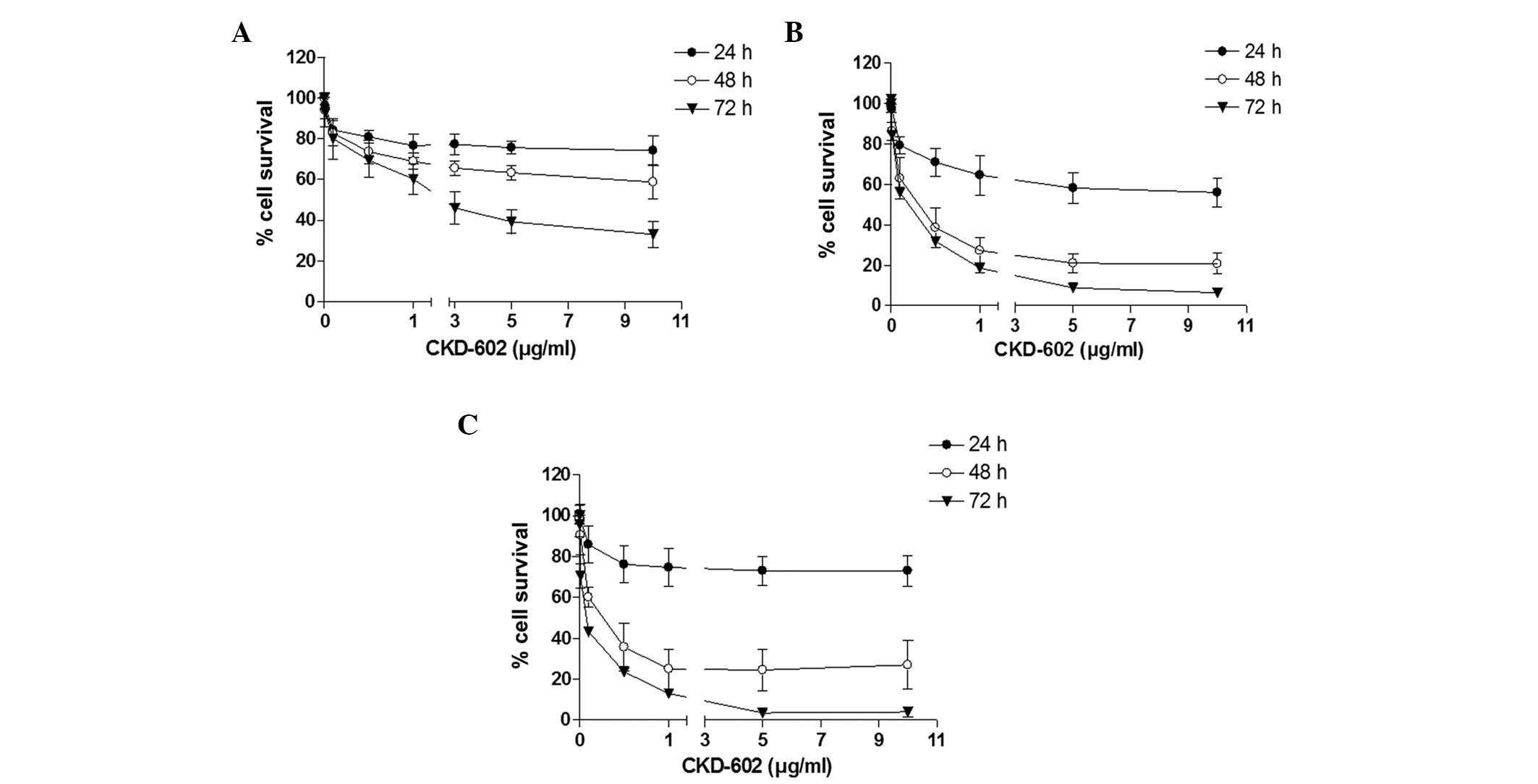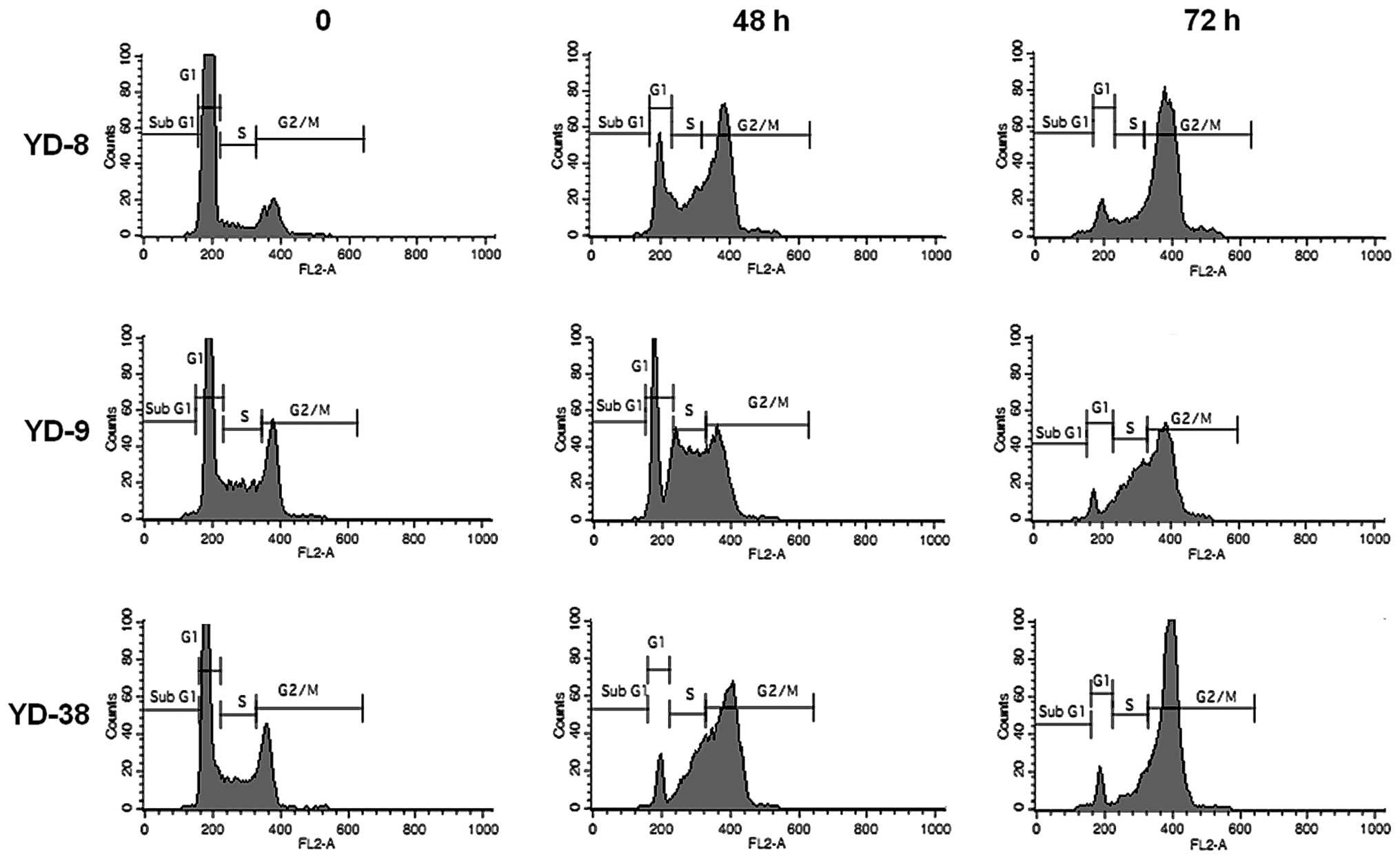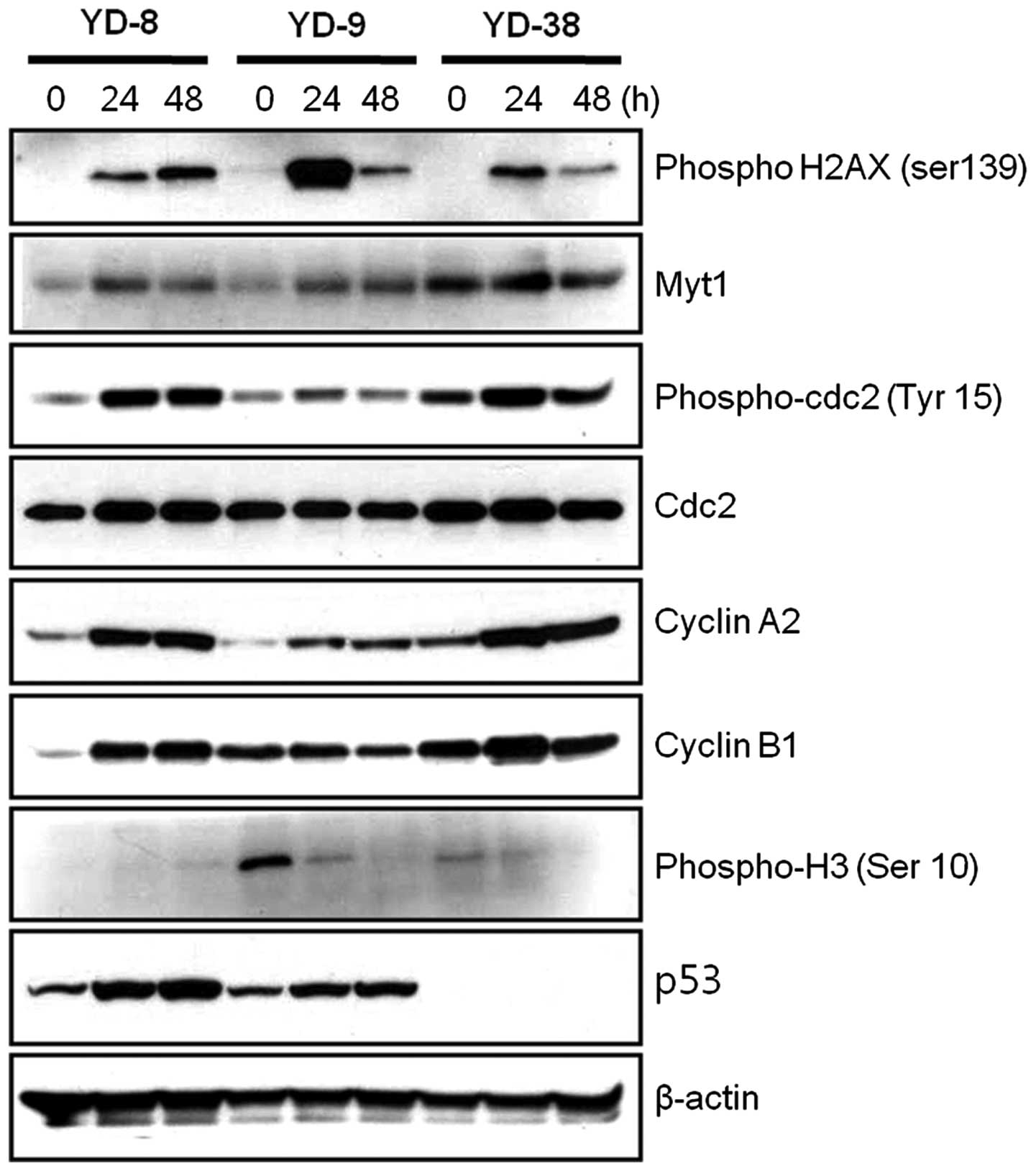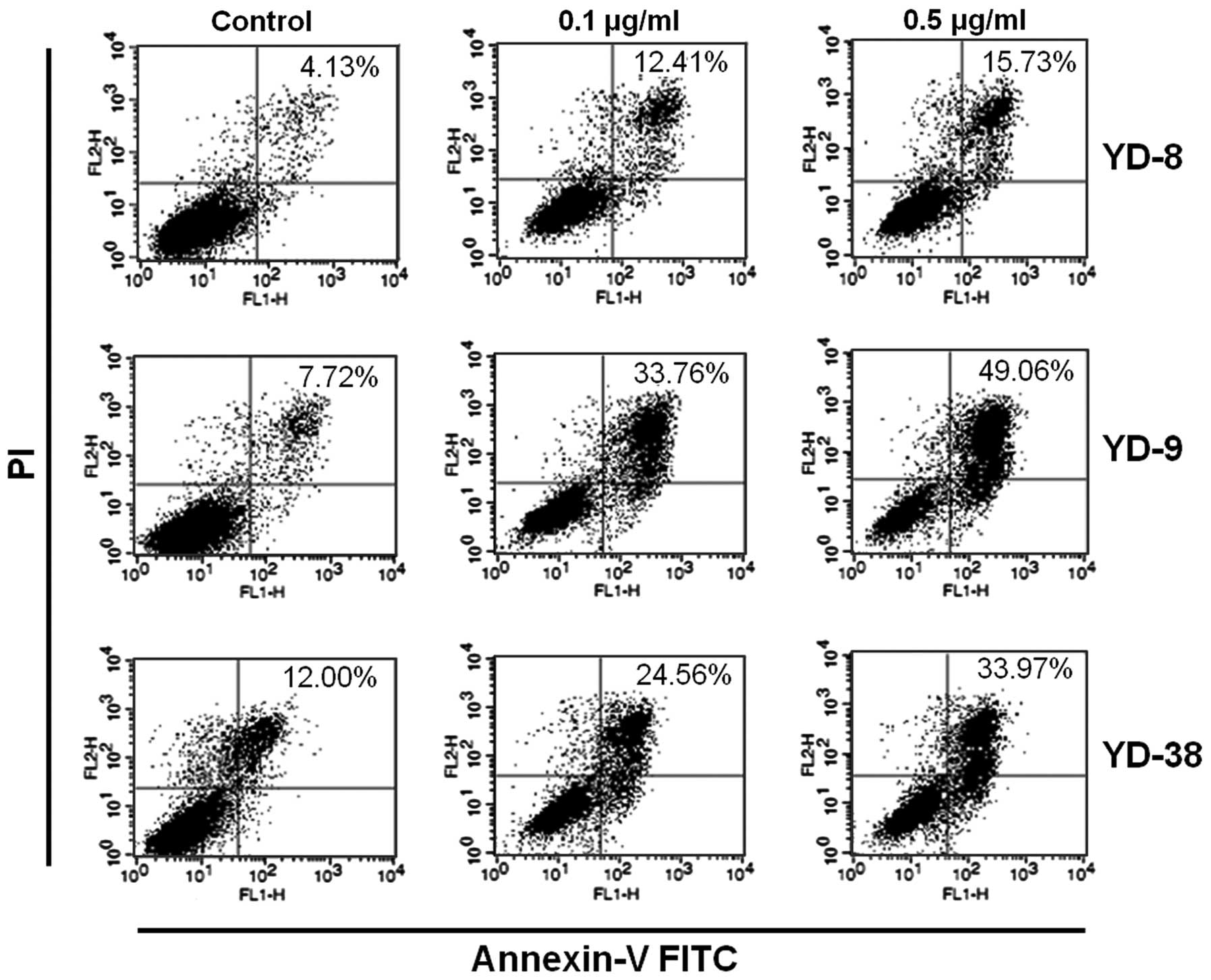Anticancer effects of CKD‑602 (Camtobell®) via G2/M phase arrest in oral squamous cell carcinoma cell lines
- Authors:
- Published online on: October 30, 2014 https://doi.org/10.3892/ol.2014.2648
- Pages: 136-142
Abstract
Introduction
Squamous cell carcinoma is the most common type of malignant neoplasm of the oral mucosa and accounts for >90% of all intraoral malignant tumors, in Korea (1). In Korea, ~20% head and neck cancer is estimated to occur in the oral region (1). Despite gradual improvements in surgery, radiotherapy and chemotherapy treatments, the prognosis of patients presenting with locally advanced oral squamous cell cancer (OSCC) remains poor, with only a 50% survival rate over five years (2). Due to these poor survival rates and the severe functional impairment caused by surgery and radiation, the development of novel therapeutic strategies in the management of patients with advanced OSCC is urgently required.
Head and neck SCC cell lines in cultures are widely used to understand therapeutic development. However, the establishment of SCC cell lines is considered difficult and low success rates have been reported. Cell lines have previously been derived from patients who had received radiotherapy, with or without chemotherapy (3); however, radiotherapy and chemotherapy eliminate sensitive cell populations and may alter the in vivo progression and cell heterogeneity of the tumor (4). Genetic abnormalities in human cancer are markedly geographically dependent, and the cultural and environmental background of the patient are closely associated with the carcinogenic process. For example, oral cancer has been clearly associated with the presence of human papillomavirus HPV16 in Western countries, but not in Korea (5). In the current study, YD cell lines, which are newly established oral cancer cell lines originating from untreated oral tumors in Korean patients, were used (5). The YD cell lines were derived from untreated primary tumors of the tongue (YD-8), buccal mucosa (YD-9) and lower gingiva (YD-38), and the cell lines exhibited genetically different p53 statuses. The YD-8 cell line had a point mutation at codon 273 of exon 8, which is involved in the DNA-binding site, revealing its significance in p53 transcriptional activation; the GGT (arginine) sequence was replaced with CAT (histidine). This R273H mutation accounts for ~20% p53 missense mutations (6). The YD-9 and YD-38 cells did not have the p53 mutation; however, the p53 protein was positively expressed in the YD-9 cells but not in the YD-38 cells. As over half of all human cancers lose p53 function through mutation (7), investigation of the potential impact of p53 mutations on disease pathology and therapeutic response is important. Tumors with an inactive mutant p53 are aggressive and are commonly resistant to ionizing radiation and chemotherapy (8).
DNA topoisomerase I (Top1), an essential nuclear enzyme that controls and modifies the topological state of DNA in numerous cellular metabolic processes (9,10), serves as a target for screening anticancer agents (10–12). CKD-602 (7-[2-(N-isopropylamino) ethyl]-(20S)-camptothecin; belotecan), a Top1 inhibitor, is a novel, synthetic, water-soluble camptothecin derivative (13). Preclinical trials of CKD-602 have demonstrated that CKD-602 exerts antitumor activity against various human tumor cell lines, and that the results are equal or superior to those of camptothecin (13). In a previous study, CKD-602 was observed to exert an in vitro anticancer effect on three OSCC cell lines, A253 (submandibular gland), HSC-3 (tongue) and KB (oral mucosa) (14). In the present study, the potential effects of CKD-602 on cell viability in OSCC cell lines originating from oral cancer in Korean patients with genetically different p53 statuses was evaluated, as well as the mechanisms underlying the induction of cell cycle arrest and apoptosis.
Materials and methods
Reagents
CKD-602 (Chong Kun Dang Pharmaceutical Corp., Seoul, Korea) was dissolved in distilled water at 1 μg/ml, and stored as a stock solution in aliquots at −20°C until use. Final concentrations between 0.01 and 10 μg/ml CKD-602 were obtained by appropriate dilutions of the stock solution with RPMI 1640 medium (Gibco-BRL, Grand Island, NY, USA).
Cell lines and cell culture
Three OSCC cell lines, YD-8 (60501; tongue), YD-9 (60502; buccal mucosa) and YD-38 (60508; lower gingiva) were used (4). All cell lines were obtained from the Korean Cell Line Bank (Seoul, Korea).
Each cell line was maintained in RPMI-1640 medium (Gibco-BRL), supplemented with 10% heat-inactivated fetal bovine serum (FBS, Gibco-BRL), 100 μg/ml streptomycin (Gibco-BRL) and 100 IU/ml penicillin (Gibco-BRL), as a monolayer under standard conditions (37°C, and in a humidified atmosphere of 5% CO2). To transfer or passage the cell lines, each confluent monolayer was washed with phosphate-buffered saline (PBS; Welgene, Daegu, Korea) and detached with a 0.05% trypsin/0.02% EDTA solution (Gibco-BRL).
MTS viability assay
Cells at a density of 2×104 cells/well in 100 μl RPMI with 10% FBS were added to the wells of a 96-well plate. The cells were treated with different concentrations (0.01, 0.1, 0.5, 1, 5 and 10 μg/ml) of CKD-602 for 24, 48 and 72 h. Control samples of each cell line were treated with medium only. For the viability assay, 20 μl/well CellTiter 96® AQueous One Solution Reagent (MTS; Promega Corporation, Madison, WI, USA) was added. After 1 h incubation at 37°C in a humidified atmosphere of 5% CO2, the absorbance at 490 nm was recorded using an ELISA plate reader (Bio-Tek Instruments, Inc., Winooski, VT, USA) The assay was performed in triplicate with three independent experiments for each condition. The data from the treatment groups were normalized to those of the control samples and are presented as the mean ±standard error of the mean. The half maximal (50%) inhibitory concentration (IC50) values were calculated from the dose-response curve.
Annexin assay
Apoptosis was quantified using fluorescein isothiocyanate (FITC)-Annexin V Apoptosis Detection kit I (BD Biosciences, San Jose, CA, USA) according to the manufacturer’s instructions. Briefly, the cells were plated at a density of 1×106 cells/well in a 100 mm culture dish, treated with 0.1 and 0.5 μg/ml CKD-602 for 48 h, and harvested by centrifugation at 500 × g for 3 min. The cell pellets were resuspended in Annexin V binding buffer containing 140 mM CaCl2, 10 mM HEPES/NaOH and 2.5 mM MgCl2. FITC-conjugated Annexin V (5 μl) and propidium iodide (PI; 5 μl) were added to the cells, and the mixtures were incubated for 15 min at room temperature in the dark. The analyses were performed using a Fluorescence-Activated Cell Sorting (FACScan) instrument (Becton-Dickinson, Franklin Lakes, CA, USA). Annexin V- and PI-positive cells were considered to be apoptotic.
Cell cycle analysis
The cells were plated at a density of 1×106 cells/well in 100 mm culture dishes. The cells were treated with 0.02 μg/ml CKD-602 for 48 h, harvested by centrifugation at 500 × g for 3 min, washed twice in ice-cold PBS, fixed in 70% ethanol and stored at −20°C for a minimum of 1 h; subsequently, cells were washed with ice-cold PBS and resuspended in 500 μl PI/RNase Staining Buffer (BD Biosciences). The cell cycle position was evaluated by FACScan using an excitation laser set at 480 nm and a detection wavelength of 575 nm. A minimum of 10,000 events/sample was analyzed.
Western blot analysis
CKD-602-treated and non-treated cells were suspended in RIPA buffer (Rockland, Gilbertsville, PA, USA) containing 5 μM AEBSF, 1.5 μM aprotinin, 10 μM E-64, 0.01 μM leupeptin and phosphatase inhibitors [1 mM sodium orthovanadate (Na2VO4; S6508; 1 mM sodium molybdate (Na2MoO4; M1003) 4 mM sodium tartrate dihydrate (S4797); 2 mM imidazole (I0125) all purchased from Sigma-Aldrich, (St. Louis, MO, USA)], and were placed on ice for 20 min. Following centrifugation at 4°C at 10,000 × g for 20 min, the cell supernatant was collected. The protein concentration was determined using a bicinchoninic protein assay kit (Pierce, Rockford, IL, USA). The whole lysate (20 μg) was resolved on a 10% or 12.5% SDS-PAGE gel, transferred to a polyvinylidene difluoride membrane (Bio-Rad, Hercules, CA, USA) by electroblotting, and probed with polyclonal rabbit anti-human β-actin (4967), monoclonal mouse anti-human p53 (9826), monoclonal mouse anti-human phospho-H3 (Ser 10; 3377), polyclonal rabbit anti-human cyclin B1 (4138), monoclonal rabbit anti-human cyclin A2 (4656), polyclonal rabbit anti-human cdc2 (9112), polyclonal rabbit anti-human phopho-cdc2 (Tyr 15; 9111), polyclonal rabbit anti-human Myt1 (4282) or polyclonal rabbit anti-human phospho H2AX (Ser 130; 9718) antibodies (1:1,000; Cell Signaling Technology, Inc. (Danvers, MA, USA) overnight at 4°C. The membrane was washed three times with 1× PBS and 0.05% Tween-20 for 15 min, and incubated for 1 h with a horseradish peroxidase-conjugated polyclonal horse anti-rabbit (7074) or polyclonal goat anti-mouse (7076) antibody. (1:2,000; Cell Signaling Technology, Inc.). The blot was developed using an enhanced chemiluminescence kit (Intron Biotechnology Inc., Seongnam, Korea).
Results
Effects of CKD-602 on cell viability of OSCC cell lines
Using the cell viability assay, CKD-602 was revealed to exert a significant cytotoxic effect on all cell lines in a time- and dose-dependent manner (Fig. 1). The cell viability IC50 values were 2.4 μg/ml for YD-8, 0.18 μg/ml for YD-9 and 0.05 μg/ml for YD-38 cells at 72 h following treatment (Table I).
Effects of CKD-602 on the OSCC cell cycle
Cell cycle analysis was performed following treatment with 0.02 μg/ml CKD-602 for 48 h and 72 h in each cell line. CKD-602 induced G2/M phase cell accumulation in all cell lines (Fig. 2). The proportion of the cell population in G2/M phase at 72 h increased from 11.9±3.8 to 77.6±0.3% for YD-8 cells, from 25.2±3.6 to 54.0±5.4% for YD-9 cells and from 19.6±3.5 to 78.3±2.6% for YD-38 cells. The percentage of the cell population in the G1 phase at 72 h was reduced from 81.7±6.48 to 10.9±2.0% for YD-8 cells, from 49.4±4.5 to 7.3±1.56% for YD-9 cells and from 58.8±7.0 to 9.0±2.9% for YD-38 cells.
Effects of CKD-602 on cell cycle regulatory protein expression levels
As CKD-602 induced G2/M phase arrest in the OSCC cell lines, whether alterations in the cell cycle regulatory proteins occurred following treatment with a non-cytotoxic dose of CKD-602 (0.02 μg/ml) was subsequently investigated. The phosphorylation of histone H2AX (γH2AX) Ser 139 is one of the early events initiated by double-stranded DNA breaks. Immunoblotting analysis revealed that the phosphorylation of histone H2AX was increased in the CKD-602 treatment cells. In the cell cycle, distinct cyclin/cyclin-dependent kinase complexes are activated to regulate cell cycle progression. Cyclin A- and cyclin B-associated cdc2 regulates the G2/M phases. During G2 phase, the cdc2/cyclin B complex is maintained as inactive by the phosphorylation of cdc2 Tyr 15 and Thr 14 by the Myt1 kinases (15–17). As shown in Fig. 3, the Myt1 protein expression levels in the three YD cell lines were observed to be increased at 24 h and reduced at 48 h CKD-602 treatment. The expression of cdc2, which is involved in cell cycle arrest in the G2 phase, was not significantly affected by CKD-602 as compared with the control treatment, however, the phosphorylated form, phospho-cdc2 (Tyr 15), was significantly increased at 24 h in all three YD cell lines, and reduced at 72 h in the YD-9 and YD-38 cells (P<0.05). Cyclin A2 protein expression levels were increased at 24 h and 48 h in the three YD cell lines subsequent to CKD-602 treatment as compared with the controls. Cyclin B1 protein expression levels were increased at 24 h following CKD-602 incubation in YD-8 and YD-38 cells, however, no change at 24 h was observed in the YD-9 cell line. These increases in cyclin B1 expression levels were reduced at 48 h following CKD-602 treatment in the YD-9 and YD-38 cell lines. p53 protein expression was detected by immunoblotting in the YD-8 and YD-9 cells, but not in the YD-38 cells (Fig. 3).
As the phosphorylation of histone H3 is a molecular checkpoint for entering mitosis (18), the phosphorylation of histone H3 Ser 10 following CKD-602 treatment was examined. As shown in Fig. 3, the phosphorylation of histone H3 Ser 10 was significantly reduced in a time-defendant manner in the YD-9 and YD-38 cell lines following CKD-602 treatment (P<0.05), however, this was not detected in the YD-8 cell line.
Effects of CKD-602 on apoptosis in OSCC cell lines
Annexin V/FITC staining, along with flow cytometry, enables the quantitative assessment of living (Annexin V-FITC-negative/PI-negative), early apoptotic (Annexin V-FITC-positive/PI-negative), late apoptotic/necrotic (Annexin V-FITC-positive/PI-positive) and dead (Annexin V-FITC-negative/PI-positive) cells. The effects of 24 h CKD-602 treatment on YD cell apoptosis are shown in Fig. 4 and Table II. The cells in the lower right quadrant indicate early apoptosis and the cells in the upper right quadrant signify late apoptosis. The proportion of Annexin-V/FITC-staining cells was markedly increased in a dose-dependent manner following treatment with CKD-602. However, the apoptotic proportion was lower in the YD-8 cells than in the YD-9 or YD-38 cell lines.
Table IIResults of FACS analysis evaluating apoptotic effects following treatment with CKD-602 for 48 h. |
Discussion
Topoisomerase inhibitors are a class of agents that target topoisomerase specifically by intercalating inside the topoisomeares cleavage complexes and mediate the changes in DNA structure during the normal cell cycle. Recently, topoisomerases have become widely investigated targets for cancer chemotherapy treatment. Topoisomerase inhibitors are hypothesized to suppress the regulatory step, which normally reseals the parent strand of DNA following passage of the daughter strand (19). The collision of the replication fork with the cleaved strand of DNA causes an irreversible double-stranded DNA break, which arrests the process of cell division and results in cell death (19).
CKD-602 is a potent Top1 inhibitor that successfully overcomes the poor water solubility and toxicity of the corresponding parent drug, camptothecin. Clinical trials for the treatment of various types of cancer with CKD-602 are ongoing and have shown promising results (13,14,20,21). CKD-602 may have potential in the treatment of patients with oral squamous cell carcinoma, as determined by the potent anticancer effects of the drug (14).
In the present study, CKD-602 induced cytotoxicity in OSCC cell lines, causing apoptosis in a dose- and time-dependent manner. The cytotoxic effect of CKD-602 was more prominent in the YD-9 and YD-38 cell lines, which did not possess p53 mutations, than in the YD-8 cell line, which did have a p53 mutation (Fig. 1 and Table I). Furthermore, the YD-9 and YD-38 cell lines exhibited more prominent apoptosis than the YD-8 cell line following CKD-602 treatment (Fig. 4 and Table II). Conflicting data have been reported concerning the influence of the p53 gene on the efficacy of topoisomerase inhibitors. Wang et al (22) demonstrated that a p53 disruption sensitizes glioblastoma cells to Top1 inhibitor-mediated apoptosis and wild-type p53 promotes a senescence-like phenotype, subsequent to SN-38 treatment. In another study, the cytotoxic effect of CKD-602 was more prominent in mutant p53 cell lines than in wild-type p53 cell lines (20). The involvement of p53 in the cytotoxic effects of anticancer agents remains under debate. Conflicting results have been generated using genetic models where p53 function has been modified by E6 protein expression (22,23) or homologous recombination (24), as cells with non-functional p53 may develop greater sensitivity, greater resistance or retain the same sensitivity, depending on the drug administered and the cellular context. Recent studies have refuted the role of p53 in determining differential susceptibilities to Top1 inhibitor (25,26). As determined by this evidence, the association between the p53 status and the effect of Top1 inhibitors, including CKD-602, requires further evaluation.
As over half of human tumors exhibit a p53 mutation or deficiency, the investigation of cell cycle checkpoints in tumor cells with various p53 statuses provides a potential basis for developing novel tumor therapeutics. In the present study, three OSCC cell lines were used with genetically different p53 statuses. The YD-8 cell line had a point mutation at codon 273 of exon 8 and the GGT sequence was altered to CAT, which resulted in a change from arginine to histidine. The levels of p53 protein were detected in YD-8 and YD-9 by immunoblotting (Fig. 3). As the half-life of wild type p53 protein is several minutes, p53 protein levels in normal cells are relatively low and are generally undetectable by immunoblotting. An abnormal p53 protein may be easily detected by immunoblotting due to the prolongation of half-life. However, the YD-9 cell line, which did not exhibit the p53 mutation, positively expressed the p53 protein (Fig. 3). Several possible underlying mechanisms, other than a point mutation, may result in the overexpression of the p53 protein (27,28). For example, genetic alternations in another region of the exon, such as the promoter or the intron of the p53 gene, may result in higher expression levels of the wild-type p53. The YD-38 cell line did not possess a p53 gene mutation and the p53 protein was not detected by immunoblotting (Fig. 3).
Treatment of the cells with CKD-602 for 48 h and 72 h resulted in cell cycle arrest at the G2/M phase (Fig. 2). This effect was associated with alterations in the expression of cyclins, including cyclin A and cyclin B1, molecules which provide molecular determinants for the cell cycle. This finding coincides with those from other studies with regard to the effect of CKD-602 on glioma cell lines. Kim et al (20) reported a reduction in the percentage of cells in the G1 phase and an increase in the percentage of cells in the G2/M phases in the U87 MG, U343 MG, U251 MG and LN229 human glioma cell lines following treatment with CKD-602.
In conclusion, in the present study, CKD-602 was demonstrated to exert an in vitro anticancer effect against OSCC cell lines by promoting cell cycle arrest in the G2/M phase and by inducing apoptosis. These findings suggest that CKD-602 is a promising candidate for use in oral cancer therapy and provides a rationale for the further evaluation of CKD-602 treatment in oral cancer by in vivo and clinical studies.
Acknowledgements
This study was supported by the SNUBH Research Fund (grant no. 02-2011-001).
References
|
Kim KM, Kim YM, Shim YS, et al: Study Group of Korean Society of Head and Neck Surgerons: Epidemiologic survey of head and neck cancers in Korea. J Korean Med Sci. 18:80–87. 2003. View Article : Google Scholar : PubMed/NCBI | |
|
Parkin DM: Global cancer statistics in the year 2000. Lancet Oncol. 2:533–543. 2001. View Article : Google Scholar | |
|
Easty DM, Easty GC, Carter RL, Monaghan P and Butler LJ: Ten human carcinoma cell lines derived from squamous carcinomas of the head and neck. Br J Cancer. 43:772–785. 1981. View Article : Google Scholar : PubMed/NCBI | |
|
Nicolson GL: Tumor progression, oncogenes and the evolution of metastatic phenotypic diversity. Clin Exp Metastasis. 2:85–105. 1984. View Article : Google Scholar : PubMed/NCBI | |
|
Lee EJ, Kim J, Lee SA, et al: Characterization of newly established oral cancer cell lines derived from six squamous cell carcinoma and two mucoepidermoid carcinoma cells. Exp Mol Med. 37:379–390. 2005. View Article : Google Scholar : PubMed/NCBI | |
|
Scheffner M, Werness BA, Huibregtse JM, et al: The E6 oncoprotein encoded by human papillomavirus types 16 and 18 promotes the degradation of p53. Cell. 63:1129–1136. 1990. View Article : Google Scholar : PubMed/NCBI | |
|
Hainaut P, Hernandez T, Robinson A, et al: IARC Database of p53 gene mutations in human tumors and cell lines: updated compilation, revised formats and new visualisation tools. Nucleic Acids Res. 26:205–213. 1998. View Article : Google Scholar : PubMed/NCBI | |
|
Tagscherer KE, Fassl A, Sinkovic T, Combs SE and Roth W: p53-dependent regulation of Mcl-1 contributes to synergistic cell death by ionizing radiation and the Bcl-2/Bcl-XL inhibitor ABT-737. Apoptosis. 17:187–199. 2012. View Article : Google Scholar | |
|
Champoux JJ: DNA topoisomerases: structure, function, and mechanism. Annu Rev Biochem. 70:369–413. 2001. View Article : Google Scholar : PubMed/NCBI | |
|
Pommier Y, Leo E, Zhang H and Marchand C: DNA topoisomerases and their poisoning by anticancer and antibacterial drugs. Chem Biol. 17:421–433. 2010. View Article : Google Scholar : PubMed/NCBI | |
|
Gupta M, Fujimori A and Pommier Y: Eukaryotic DNA topoisomerases I. Biochim Biophys Acta. 1262:1–14. 1995. View Article : Google Scholar : PubMed/NCBI | |
|
Wang JC: Cellular roles of DNA topoisomerases: a molecular perspective. Nat Rev Mol Cell Biol. 3:430–440. 2002. View Article : Google Scholar : PubMed/NCBI | |
|
Lee JH, Lee JM, Kim JK, et al: Antitumor activity of 7-[2-(N-isopropylamino)ethyl]-(20S)-camptothecin, CKD602, as a potent DNA topoisomerase I inhibitor. Arch Pharm Res. 21:581–590. 1998. View Article : Google Scholar | |
|
Ok YJ, Myoung H, Kim YK, et al: Apoptotic effect of CKD-602 (Camtobell) on oral squamous cell carcinoma cell lines. Oral Oncol. 45:266–272. 2009. View Article : Google Scholar | |
|
Booher RN, Holman PS and Fattaey A: Human Myt1 is a cell cycle-regulated kinase that inhibits Cdc2 but not Cdk2 activity. J Biol Chem. 272:22300–22306. 1997. View Article : Google Scholar : PubMed/NCBI | |
|
Liu F, Stanton JJ, Wu Z and Piwnica-Worms H: The human Myt1 kinase preferentially phosphorylates Cdc2 on threonine 14 and localizes to the endoplasmic reticulum and Golgi complex. Mol Cell Biol. 17:571–583. 1997.PubMed/NCBI | |
|
Parker LL and Piwnica-Worms H: Inactivation of the p34cdc2-cyclin B complex by the human WEE1 tyrosine kinase. Science. 257:1955–1957. 1992. View Article : Google Scholar : PubMed/NCBI | |
|
Van Hooser A, Goodrich DW, Allis CD, Brinkley BR and Mancini MA: Histone H3 phosphorylation is required for the initiation, but not maintenance, of mammalian chromosome condensation. J Cell Sci. 111:3497–3506. 1998.PubMed/NCBI | |
|
Holden JA: DNA topoisomerases as anticancer drug targets: from the laboratory to the clinic. Curr Med Chem Anticancer Agents. 1:1–25. 2001. View Article : Google Scholar | |
|
Kim YY, Park CK, Kim SK, et al: CKD-602, a camptothecin derivative, inhibits proliferation and induces apoptosis in glioma cell lines. Oncol Rep. 21:1413–1419. 2009.PubMed/NCBI | |
|
Lee JH, Lee JM, Lim KH, et al: Preclinical and phase I clinical studies with Ckd-602, a novel camptothecin derivative. Ann N Y Acad Sci. 922:324–325. 2000. View Article : Google Scholar | |
|
Wang Y, Zhu S, Cloughesy TF, Liau LM and Mischel PS: p53 disruption profoundly alters the response of human glioblastoma cells to DNA topoisomerase I inhibition. Oncogene. 23:1283–1290. 2004. View Article : Google Scholar : PubMed/NCBI | |
|
Gupta M, Fan S, Zhan Q, et al: Inactivation of p53 increases the cytotoxicity of camptothecin in human colon HCT116 and breast MCF-7 cancer cells. Clin Cancer Res. 3:1653–1660. 1997. | |
|
Bunz F, Dutriaux A, Lengauer C, et al: Requirement for p53 and p21 to sustain G2 arrest after DNA damage. Science. 282:1497–1501. 1998. View Article : Google Scholar : PubMed/NCBI | |
|
Djuzenova CS, Güttler T, Berger S, Katzer A and Flentje M: Differential response of human glioblastoma cell lines to combined camptothecin and ionizing radiation treatment. Cancer Biol Ther. 7:364–373. 2008. View Article : Google Scholar | |
|
Morandi E, Severini C, Quercioli D, et al: Gene expression time-series analysis of camptothecin effects in U87-MG and DBTRG-05 glioblastoma cell lines. Mol Cancer. 7:662008. View Article : Google Scholar : PubMed/NCBI | |
|
Wong RH, Du CL, Wang JD, et al: XRCC1 and CYP2E1 polymorphisms as susceptibility factors of plasma mutant p53 protein and anti-p53 antibody expression in vinyl chloride monomer-exposed polyvinyl chloride workers. Cancer Epidemiol Biomarkers Prev. 11:475–482. 2002.PubMed/NCBI | |
|
Yook JI and Kim J: Expression of p21WAF1/CIP1 is unrelated to p53 tumour suppressor gene status in oral squamous cell carcinomas. Oral Oncol. 34:198–203. 1998. View Article : Google Scholar : PubMed/NCBI |













